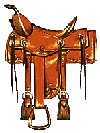|
The History
|
The saddle, ranging from a simple saddle cloth to configurations more in common with today's saddles, have origins in the Middle East and Siberia many centuries before Christ.
However the saddle as we know it today is usually credited to the Romans. The Romans made the transition from foot soldier to mounted cavalry following defeats at the hands of Carthaginians and by Hannibal's armies mounted on Iberian and North African horses.
The Roman saddles influenced the makeup of the Moorish or Spanish saddles which eventually found their way to America, evolving into the Western Saddle.
The other branch of the tree was formed as the Roman saddle evolved into the saddles of the war horses of Europe culminating in the Hungarian Saddle and what we today call the English Saddle.
The English Saddle
 Saddles used during the Middle Ages were generally of a back seat type with the mounts being heavy cold bloods. Power was the name of the game here and a secure seat on the war horse was a priority.
Saddles used during the Middle Ages were generally of a back seat type with the mounts being heavy cold bloods. Power was the name of the game here and a secure seat on the war horse was a priority.
The Germans and Hungarians refined these saddles by developing lighter weight saddle designs enabling the horse and rider to jump over enemy foot soldiers as well as out-maneuver slower armored knights.
What we call the English saddle might more appropriately be referred to as the European saddle, having its roots in these lighter weight saddles.
It was the invention of firearms that the reestablished a need to return to the swift warm blooded chargers and the Spanish and Barb breeds once again gained favor. The changes from power to speed in fighting tactics further influenced the design of the warrior's lightweight saddles.
The training of large numbers of cavalry recruits to meet these changes was normally a long and tedious process. It was in addressing this issue that a major change in saddlery occurred, leading to what we today refer to as the English Forward Seat saddle. An Italian cavalry officer by the name of Frederico Caprilli introduced the school of forward seat riding in the late 19th century.
Caprilli's Forward Seat saddle concept initially was met with skepticism and downright hostility but the Forward Seat eventually replaced the fashionable English backward seat as the saddle of choice for the sport of fox hunting. The rest, as they say, is history.
The Western Saddle
 The Western saddle originated in Spain, its evolution influenced by Celtic, Roman and Arabian/Moorish riding traditions. An offspring of the Moorish saddle or "saddle of the Conquistadores" the Western saddle came to the United States via Mexico as a working saddle.
The Western saddle originated in Spain, its evolution influenced by Celtic, Roman and Arabian/Moorish riding traditions. An offspring of the Moorish saddle or "saddle of the Conquistadores" the Western saddle came to the United States via Mexico as a working saddle.
The early Spanish colonists modified the Conquistador's saddles to better meet their needs for working cattle. These modifications eventually led to the Mexican Vaquaro saddle which has remained relatively unchanged since the early 1700's.
THe Mexicans perfected the art of carving the tree from wood and covering it with wet rawhide producing an exceptionally strong and durable wood and leather saddles as we are familiar with today. The Mexican saddle also featured a saddle horn invented as an alternative to tying the rope to the horses tail when roping cattle, an innovation no doubt appreciated greatly by the horse.
The Mexican Cowboy saddle evolved into the Texas saddle, characterized by double rigging which greatly increased the stability of the saddle and rider under rough working conditions. It was about this time, the 1880's, that fenders to protect a riders legs came into use. The need for added comfort and durability for the long cattle drives in the late 19th century also influenced the evolution of the Western saddle into the saddle we are familiar with today.
Saddle styles have been named after geographical areas, companies, individuals, and various other things. So don't feel like a complete tenderfoot if someone rattles off several saddle types by name. They probably don't know any more than you unless they're an expert on saddles and saddle history.
Improvements in strength, comfort and functionality continued into the 20th century with innovations such as wider stirrup treads and rough-out seats and continue today with the use of synthetic materials such as Ralide and Cordura to produce a wide variety of choices and a wide range of styles to fit particular needs.
We'll briefly describe several of the more commonly used styles fittting both categories, provide you some advice on what approach you need to take to get a properly fitting saddle when ordered over the Internet, and assist you in getting in touch with some of the top saddlemakers and retailers.